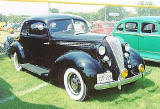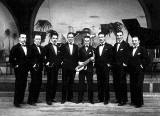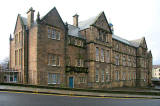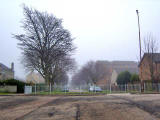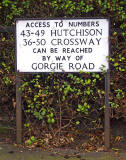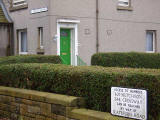|
Recollections Hutchison & Chesser |
|
|
1. George T Smith British Columbia, Canada |
|
|
2. George T Smith British Columbia, Canada (again) |
|
|
3. Harry Sutherland Hutchison, Edinburgh |
|
|
4. William Sinclair Toronto, Ontario, Canada |
|
|
5. Ken Smith Calgary, Alberta, Canada |
|
|
6. George Ferguson Saginaw, Michigan, USA |
|
|
7.
Betty McGill Edinburgh |
|
|
8.
Maureen Lucano |
|
|
9.
S Oliver |
|
|
10. George T Smith British Columbia, Canada |
|
|
11. David Wood Newmarket, Suffolk, England |
|
|
Please click on one of the links above, or scroll down this page. |
|
|
More Pages |
|
|
George T Smith British Columbia, Canada |
|
|
Recollections 1. George T Smith Nanaimo, Vancouver Island, British Columbia, Canada |
|
1940s Thank you to George T Smith, now living in British Columbia, Canada, for sending these recollections of the time he spent in the Hutchison and Chesser districts of Edinburgh in the 1940s. George's memories include: |
|
Hutchison Road "From the age of 6, I lived in Hutchison Road which was a source of wonder to me as there were: - railway trains passing slowly towards the cattle market sidings, some containing livestock, others troops - a view of Corstorphine Hill - in the middle view the trees of Saughton park with a mysterious turreted house in it, rumoured by my school mates to be haunted. The street had some claim to fame as at the east end, at the bottom of Moat Drive, was ‘the field’ across which we tramped daily as a short-cut to Craiglockhart school. The field had been the site for one week, early in the century, of Buffalo Bill Cody’s 'Wild West Show' to which special trains were run from the Waverley." |
|
"The housing scheme was a product of a late-twenties building expansion of Corporation housing. It was formed of blocks of three story flats (ground floor and two upper floors) each ‘stair’ consisting of six two bedroomed flats, heated by a coal fire in the living room and, for the more affluent the option of using of gas fires in the bedrooms – usually when kids were sick." |
|
"Moving west: at the junction of Hutchison Causeway was the factory of Manclark & Son, uniform manufacturers. It seemed staffed by girls from the Calders." |
|
"Next was a ‘pipe field’ a depot for water department pipes of all sizes including one or two ancient wooden ones. As kids do, we climbed the fence and rooted around and met with the night watchman who delighted in story- telling though mystifying us 8-year-olds with tales of Thomas Paine and 'The Rights of Man." |
|
"Adjoining the field was the remains of the old Gorgie Farm which was run as a laundry, Hillview Laundry’ I believe." |
|
"Next came a small lemonade factory which distributed lemonade in small globular bottles, sometimes used in our mock battles as grenades, though more usually carefully collected for the deposit refunds which we squandered on ‘Vantas’ at one of the small shops in the little circular shopping area in Hutchison Avenue. Hudson Terraplane Recent references to the Hudson Terraplane reminded me that the owner of the lemonade factory owned such a vehicle. It was an object of curiosity to us small boys just after the war when private cars were few and big US imports even fewer. I suspect it was a pre-war vehicle and it sure was big compared to our Austin Seven." |
|
"Useful shops at Hutchison Medway were: - the paper shop - vegetable (and Vantas ) shop - sweet shop - hairdresser - a sub post office cum lending library - Sutherlands, the butcher shop. - a 'standby' a Fish & Chip shop - a couple more useful stores." |
|
"One now out-dated oddity was the Co-op firewood factory. Here, logs were split into bunches of kindling which were wired up and sold at the ‘Store’. Its death knell must have been the Clean Air Act of 1956." |
|
"Finally there came the large Co-Op laundry (now, I believe, a supermarket). It handled ‘bagwash’ and and returned it a few days later in a brown paper parcel of carefully washed, dried, ironed and folded fresh smelling clothing etc." |
|
"The co-op operated both motor and horse-drawn vehicles, the latter providing valuable nutrient to our ‘Dig for Victory’ vegetable plots which we loyally dug in the back greens during the war years. These same backgreens were also our venue for ‘backgreen concerts’ where our very amateur efforts raised sixpences for the 'Spitfire Fund' and other charities." |
|
"The cattle market and abattoir was a source of holiday education where we looked in on the auctions and listened to rapid fire auctions for sheep and cattle. Frequently the livestock were herded along our road towards the market and, occasionally, a cow would balk and return at a run from the market direction pursued by a irate herdsman and, on one occasion, disrupting a game of rounders. Then it was still possible – few private cars and petrol rationing – for children to play in the street." |
|
"The markets also included places barred to kids such as the Corn Exchange and The Gothenburg, a pub. The enclosure on Chesser Avenue, where sheep were often kept for a few days, was also the site of some sort of Highland Games where I recollect some sweating brawny policemen heaving 56 lb weights over what seemed an impossibly high bar." |
|
"Our playgrounds were the streets and backgreens. But as we grew older we went further afield to such as: - the Union Canal - Hailes Quarry, then 100 feet deep and filled to some 40 feet with spring water - Craiglockhart - Colinton Dells." |
|
"Hutchison had some sporting connection too. A football team ‘Hutchison Vale’ was initiated there by a Mrs Bryson whose son I believe became a professional footballer goalkeeper. Memory says he played for Hibernian but with Hearts just down the road …….. I wonder?" |
|
George T Smith, Nanaimo, Vancouver Island, British
Columbia, Canada |
|
Recollections 2. Further Recollections George T Smith Nanaimo, Vancouver Island, British Columbia, Canada |
|
1940s Thank you to George T Smith, British Columbia, Canada, for sending me further recollections of his life in the Hutchison and Chesser districts of Edinburgh. George wrote: |
|
"Having looked at the Dumbiedykes recollections I was struck by the similarities to my own recollections of my childhood home. The names I remember are only those of families who had children of roughly the same age as myself. Looking back, despite playing in largely traffic free streets my social circle was limited to only a few adjoining blocks of flats. Starting west to east: 20 Hutchison Road - 14: Steele sisters, Catherine and Margaret Scott - 16: Alan and Rhoda Fraser, Pat and George Dixon - 18: Ian Inglis - 20: Smith family (me, Gordon, Allan and Kenneth) Fraser family, Betty and Margaret Cameron June Young Liddel family
- 22: Jimmy Dalgleish - a pall of
the Herbertson Bros Herbertson Bros I think some of the houses may have since been re-numbered. Beyond this narrow field was Harry Sutherland in Hutchison Avenue in whose house we had ’Group Teaching’ during the early days of World War II." |
|
"There is mention elsewhere of the rare cars in the street. That reminds me that, although few were parked there, one young blade in No 24 Hutchison Road had an aluminium Morgan 3 wheeler with a JAP V twin air cooled engine." |
|
"I am struck by how healthy we were despite rationing. School dinners were prepared at a central kitchen, one of which was in a converted church in Fountainbridge. Delivered in insulated containers, these meals were served up in the gymnasia (at Boroughmuir) by ‘Dinner Ladies’. The collapsible tables were erected by the pupils in the last class for PT before lunch break. The meal was usually meat ,potatoes and two vegetables followed by a dessert (puddin’ in Edinburgh vernacular) composed of a slice of steamed pudding and custard. These meals cost 4 pennies per day and were free to kids from homes on welfare support. |
|
Morning milk was supplied too at Junior School. I cannot recollect if Secondary Schools also got that. At Craiglockhart, we each got one third of a pint each day for, I think, 1/2 penny per day (free to some). It was an honour to be selected Milk Monitor and to be allowed to pierce the bottle tops with the little sharp prodder - never cleaned to my recollection. No Safe Food regulations then? |
|
"The Clydebank raids were scary enough. We glimpsed the searchlights and flak bursts from the safety of our Anderson shelters, dug into the back greens. The following morning we searched for shell fragments as souvenirs and found a few. I wonder how many casualties resulted from spectators and ‘firewatchers’ being struck by fragments from anti-aircraft shell bursts? Nose cones and base plates from the 3.7 shells often landed intact and they weighed several ounces." |
|
George T Smith, Nanaimo, Vancouver Island, British
Columbia, Canada |
|
Recollections 3. George T Smith Nanaimo, Vancouver Island, British Columbia, Canada and Harry Sutherland Harry Sutherland, Hutchison, Edinburgh |
|
|
1940s Thank you to George T Smith, British Columbia for sending the excerpt below - and thank you to Harry Sutherland, Hutchison Road, Edinburgh for the comments that I have quoted below. George wrote: |
|
|
"One of your correspondents from USA was an ex-Manclarks seamstress from the Calders. Below, I have copied a piece from a recent e-mail from Harry Sutherland at whose house I was 'Group Taught' in 1939. Harry still lives in the house and is active in the local community association." The excerpt is......
George T Smith: April 18, 2007 |
|
Recollections 4. William Sinclair Toronto, Ontario, Canada |
|
Thank you to William Sinclair, now living in Ontario, Canada, who wrote: |
|
"I lived all my life until I was married in 14 Hutchison Medway. My older sister Barbara lives in Blackhall and my young brother, George lives at Huchi View. I am a piper. I got my start at the 67 Boys' Brigade, St. Aiden's, Stenhouse. I have been in the Toronto area of Canada since 1967." See also comments from Ken Smith in 5 below |
|
"I did not know George Smith or to many families on that side of the Hutchison Road, but to the west of Hutchison Place I knew just about everyone. I remember Billy Porteous from No 12, The Medway, one of your contributors now living in Australia. |
|
The paper shop was Meiklejohns. George Meiklejohn and I flew pigeons as 'Meiklejohn & Sinclair' in the Tynecastle Flying Club. I was known then as Billy. |
|
Bruce, the son of Ma Bryson (as she was called) was a forward. Tommy Younger who was Hibs and Scotland goalie. Billy Macfarlane, also from Hutchi Vale, became Manager at Easter Road. |
|
William Sinclair, Toronto area, Ontario, Canada April 17, 2007 |
|
Recollections 4.(ctd) William Sinclair Toronto, Ontario, Canada |
|
William Sinclair sent these further recollections of the Hutchison area, a few days later. |
|
Here's more about the shops in what we called the Hutchison Circle. In the center of the circle there were two semi-circles of grass with shrub areas, surrounded by a low iron fence and a paved path down the middle. 'NO FOOTBALL ALLOWED' |
|
First was Meiklejohns (paper shop) It also sold bread & morning rolls. Next door was Mrs Wilson's (green grocers). Then Mrs Lawsons ('sweetie shop' and the penny Vantas, no Coke back then) Next door was a hairdresser |
|
Shops - SW Corner First was Bradley's( post office). Next door was Nellie Sutherland (grocers). |
|
Shops - NW Corner First was a drysalters. Next door was Joe Hewets (fish & chips) We didn't go there on a Friday lunch time as the girls from Manclarks were there then. |
|
Shops - NE Corner First was a bakers. Next door was Lawrie's (the fish monger). |
|
William Sinclair, Toronto area, Ontario, Canada April 23, 2007 |
|
Recollections 5. Ken Smith Calgary, Alberta, Canada |
|
Thank you to Ken Smith, now living in Calgary, Canada, who wrote: |
|
"I was looking over your site again and noticed the comment from William Sinclair on April 17 re. the 67th Company of the Boys Brigade. I, too, was a member, from 1943 to 1946. There was no band in those days, just lots of marching drills for the annual city-wide competition. The Captain was named Downie and the Lieutenant in charge of the drills was MacNeil. St Aiden's church, where the 67th Company met, was demolished a few years ago and there are now apartments there." Ken Smith, Calgary, Alberta, Canada: April 26, 2007 |
|
Boys' Brigade Photo Ken Smith also sent me a photograph of the Boys' Brigade 67th Company, taken in 1944 in front of the church hall by E.W. Catling, 101 Restalrig Avenue. If I can get copyright permission to add the picture to the EdinPhoto web site, I'll do that. - Peter Stubbs: April 26, 2007 |
|
Recollections 6. George Ferguson Saginaw, Michigan, USA |
|
Thank you to George Ferguson who wrote: |
|
"I was looking at your wonderful pictures of Edinburgh and came across this view of Hutchison Road. To answer Mr. George Smith's question, 'I guess the new flats on the left hand site are on the old Manclark's site'. My Mum worked at Manclark's for years and I remember we always used to go to the corner of Hutchie Road and Hutchie Crossway to meet her getting out of work at 4pm. Yes Mr. Smith is correct, my wee sister later bought one of those houses to be near my Mum who passed away in the same house I was born in. I was born in 1956 and lived at 30 Hutchison Road from day one until I joined the Army in 1973. After I left the Army I emigrated to the United States and have been here since then." |
|
"I was home last about 6 years ago for a visit and I was kind of sad to see all the changes, there is just nowhere for the bairns to play any more. When I was growing up, behind our house we had a place we called the garages because there were a couple of rows of garage lock-ups, but the best part was that there was a large field with really tall grass and hedgerows where we used to play Japs and Commandos and Hide and Seek. Unfortunately, the fields have gone. There are now about eight to ten houses where the fields used to be." |
|
"Just around the corner, there was the railway line to the cattle market which is now a road leading to a fruit market, I believe. Over the railway line were they used to park the empty cattle cars, there was a bridge The cattle cars were sometimes full of straw and we used to go along all the cattle cars (one person keeping an eye out for the railway police) and collect all the straw and put it all in the one car directly below the bridge and then jump from the bridge into the straw below. My Mother once caught us doing this and just about had a fit. Boy, did I get my backside tanned for that one. Still, it didn't deter me. We were back the next day doing it again." |
|
"Right next to the bridge was a field we used to call the Pony Field. It did actually have ponies in it at one time. I remember feeding them as a boy, though I'm not sure who they belonged to. Later, when the ponies left, we used the field for playing football, and for sledging in the winter when there was snow as the field had a small hill at the end of it." |
|
"After the railway line was closed down it became just another play area for us. We used to play on the old line all the way up to the cattle market. On Tuesdays and Wednesdays we would go to the cattle market. Tuesdays were always sheep and cattle selling days and Wednesdays were pig selling days. We would go along and watch the sheep and pigs being unloaded for sale and then go into the auctions themselves. There used to be two auction rings in the Swan building, connected by a swing door. In one ring they would be selling sheep and through the door in the second ring would be the cattle auctions. For years as a boy I used to think the auctioneers were talking in code to confuse us kids and the only ones who could understand the code were other grown-ups." |
|
"Hutchison Road wasn't a bad place to grow up. Everybody knew all their neighbors back then, but on my last visit it seemed to lack the warmth we in those days - a sign of the times, I guess. I sometimes long for home. As the old saying goes, 'You can take the boy out of Scotland but you can't take Scotland out of the boy'." |
George Ferguson, Saginaw, Michigan, USA: September 20, 2007 |
|
Recollections 7. Betty McGill (née Harvey) Edinburgh |
|
Thank you to Betty McGill (née Harvey) who wrote: |
|
"I am completely captivated re all the life stories about living in Hutchison Road. I was brought up in No 36, Hutchison Road. My maiden name is Betty Harvey." |
|
"As a child, I remember: - George Ferguson and all his family . They would know all my family too. - Billy Mcfarlane who just lived what we called 'down the key' !!! in Hutchison road. I know of Harry Sutherland. He is related to my daughter-in-law, May, who with my son and family now live in America - so 'Hello Harry'." |
|
"I, too, used to watch the cattle being auctioned when I was just a child, all gone now and houses being built everywhere." |
|
"I used to also watch the soldiers marching to the pipe band on the way to the trains at the back of the Laundry, off to war !!! We always waved to them !!!!! " |
|
Betty McGill (née Harvey), Edinburgh: December 27, 2007 |
|
Recollections 8. Maureen Carroll Luciano Virginia, USA |
|
Thank you to Maureen Lucano who wrote: |
|
"I've just finished reading William Sinclair's memories (4 above). Oh my! Did it bring back some wonderful memories! William was my neighbour at No.14 Hutchison Medway. You can understand why I got so excited reading this. All the places that William mentioned we played in, the stick factory, the pipe factory, the lemonade factory. We would climb onto the roof (fearless) at the top of Chesser Avenue." |
|
"I also stayed in No.5 Hutchison Place, and rode my bike round and round the circle. We stayed up above Lawrie's Fish Shop and Mrs Dunnet the bakers. Joe Hewitt was my favourite at the Fish and Chip Shop. He would make sure I got extra batter off the fish in my order." |
|
"Brian, my young brother, knew everyone in Hutchison. He was a lovely young boy. Unfortunately, he passed away suddenly 2004. I mention Brian because he was mentally handicapped and everyone was so kind to him in Hutchison." |
|
"I remember: - Backgreen concerts in Hutchison Road, a penny to get in, the neighbours would give us old clothes to dress up in. - The Roley Poley Hill and the Cattle Market. - Further up to the river, where someone had tied a heavy rope and a rubber tire. We would swing across the river. - Redhall Park and the school playing field at Redhall. - Saughton Park where we wondered if we should try to go into the HAUNTED HOUSE. No we did not. It was off limits. - Medway Swing Park behind our house at Hutchison Medway. We used to have Guy Fox night there with a Bonfire on 5th November." So many good memories. We did not have to go far afield to enjoy ourselves." |
|
"We moved to No.5 Hutchison Ave, ground floor with a garden. My parents were elderly then and could not climb the stairs at No.14. When they passed it was the end of an era, I sold the house. I have lived in the States since 1965, so my time in Hutchison was from 1942 to 1965." |
|
Maureen Carroll Luciano, Virginia, USA: February 6, 2008 |
|
Recollections 9. Steven Oliver Duns, Borders, Scotland |
|
Thank you to Steven Oliver who wrote: |
|
"I’ve been reading George Ferguson’s recollections (6 above) with regard to the Hutchison area and I can confirm that part of the old railway line is now the access road to the Fruit Market, which is accessed from Hutchison Crossway. I believe that the Fruit Market site is due for redevelopment shortly." |
|
The photographs above were taken by Steven Oliver, Duns, Borders, Scotland. Steven explains: "Hutchison Crossway is in itself interesting. It was built in two sections, linked by a footbridge. I presume, is the one that George mentions in his recollections. The sections of road were: - from Gorgie Road to the railway line, and - from the railway line to Hutchison Road and on Slateford Road. At some point, after the closure of the railway line, the Fruit Market was built, and the section of Hutchison Crossway leading from Gorgie Road was extended to the former railway line to provide access to it where the footbridge used to be. Here it met the section running from Slateford Road. But a wall was built (now a fence) to separate the two sections of the street to prevent vehicles from using it as a short cut. A gap was provided for pedestrians. At the Slateford Road end of Hutchison Crossway, there is this sign: At the Gorgie Road end of Hutchison Crossway, there is this sign: Rather oddly, the street lights also provide a clue to the history of the street. The section from Gorgie Road to the old railway line has lampposts more usually found on main roads, while the section from there to Slateford Road has residential street lighting. Additionally, the north section is wider than the south section." |
|
Steven Oliver, Duns, Borders, Scotland: February 9, 2008 |
|
Recollections 10. George T Smith Nanaimo, Vancouver Island, British Columbia, Canada |
|
After reading about rhones and rhone pipes on the Edinburgh Names and Slang page, George wrote: |
|
Climbing the Rhone Pipes "My recollection of the 'rhone-pipe' is that of a source of casual income to agile boys around the three-storey tenement blocks at Hutchison. When a neighbour locked herself out of her flat (through not 'putting on the sneck' and then forgetting her key) she would enlist the help of a boy like me who would:
-
climb up the drainpipe Payment was not royal. It might only be a biscuit or a few sweeties but one gained a reputation of being 'a good wee laddie' I have no memory of any accidents occurring but we were always enjoined to be careful lest the pipe fall away from the wall. That seems unlikely as they were cast iron pipes with frequent sleeve joints (handy footholds) unlike the fragile aluminium hardware to be found here in Canada." |
|
George T Smith, Nanaimo, Vancouver Island, British
Columbia, Canada |
|
Recollections 11. David Wood Newmarket, Suffolk, England |
|
Thank you to David Wood for sending me his memories of living in the Hutchison and Chesser district between about 1948 and 1963. (He was born there in late-1944.) David wrote: |
|
Gorgie Market "We lived in a flat on Hutchison Terrace, the western boundary of the eponymous council estate which overlooked an open aspect of overnight pastures for stock awaiting sale at Gorgie market – many a night I fell asleep to the gentle lowing of sheep, or the occasional bellow of cattle, in the field on the other side of the road. Market days were Tuesdays and Wednesdays, when Chesser Avenue would be lined with the cars of the traders and farmers. At a time when cars were still scarce, this was a great place to see exotic machinery, like Armstrong Siddeleys; Jaguars, Bristols and Humbers! During snowy winters, the market field to the NW of Chesser Avenue was ideal sledging territory with a short, but steep, slope into a hollow. It was brief walk home - just long enough to realise that your wellies were full of melting snow." |
|
"In the days before TV (we got our first set only in 1962), we went regularly to the cinema. There were three within easy reach: - The Lyceum - The Roxy - The Tivoli. The first two were within walking distance. My Dad had one of the first cars, but it was kept in a far-off lock-up and not used for such trivial outings!" The Lyceum "I used to go to the ‘ABC Minors’ matinee on a Saturday morning at the Lyceum (which was a dingy hole, even by the cinema standards of the time) to see endless serials of : - ‘Flash Gordon’ - ‘Superman’ or - ‘The Bowery Boys’ prefacing a main feature usually with - ‘Abbott and Costello’ or - ‘Old Mother Reilly’ However, I can still remember the excited queue of lads one Saturday afternoon, outside the Lyceum, for the first viewing of the eagerly awaited: - ‘Dambusters’. There was much weaving and droning with arms outstretched on the way home that day. The Lyceum eventually burnt down, probably due to its retention of gas safety lighting." The Roxy "The Roxy was a paragon of bright modernism, always smelling of a mixture of hot ‘Butterkist’ and pine disinfectant." The Tivoli "The Tivoli was too far to walk to, so the bus journey could only be justified by a specially selected film, although in later, teenage years, the ‘chummy’ seats in the back rows of its balcony were much prized for primitive fumbles when the usherette’s torch was elsewhere!" |
|
"In those days, before supermarkets, Hutchison estate was served by two groups of shops.: - The St Cuthberts Co-op occupied a terrace of shops at the top of Chesser Avenue, with dedicated units - baker, butcher, grocer, chemist etc. - ‘Hutchison Circle’, in the centre of the estate, had independent shops with newsagent, post office, fishmonger and - a major element in our lives – a fish n’ chip shop! Rationing was still in force for part of the 1950s. I remember waiting, with my Mum, on a line of benches in the middle of the Co-op grocer for our turn to go up to the marble counter where a white-coated god graciously cut a portion of cheese from a large block with a shiny wire cutter. The butchers was something else . I still remember with some horror the sight of a headless, hoofless, gutless, carcass of a pig, hanging on a hook, dripping the odd spot of blood onto the sawdust-covered floor. Strange to say, I was a ‘fussy eater’ for many years from my childhood. One mystery of the Co-op was ‘the book’ This was seemingly linked to a shareholding which my parents had in the Co-op, and could be used to buy items on credit up to some limit ( £12-15/- ?) I would be sent shopping for a few items, without cash but with ‘the book’, in which the shop assistant would make some entry. It seemed like magic. 'May the book be with you!' The newsagent in the ‘Circle’, ‘Meiklejohns’ played a significant role in my teenage years because I earned my pocket money by delivering newspapers etc. I did both daily afternoon papers, and Sunday morning papers, rolls and milk. For a while, this funded a comparatively affluent lifestyle - including visits with some young ladies to the aforementioned Tivoli! Fridays were marked, literally, by the ‘Peoples Friend’ - a DC Thomson publication, notable mainly for its lurid blue and brown covers rather than its literary content. I think that most of DC Thomson’s weekly surplus of cyan ink ended up on my fingers!" |
|
"The Water of Leith marked the normal boundary of operations for me and my friends. There were two accessible parts: - the southern, wooded, area from Slateford bridge to Saughton Cemetery - the northern waterside section from the cemetery to Saughton Park. (I don't think there was a waterside path around the cemetery at the time, as there is now, but we gave it a wide berth anyway.) The southern section could be reached through Gorgie Market, via the obsolete LMS sidings, or from the banks of the Union Canal. The latter route led to the discovery that the canal aqueduct was a hollow structure. Climbing inside this became something of a rite of passage amongst us, but one needed to be slim and agile. (Now, alas, it's a distant memory.) The northern section, to Chesser bridge, was a focus for ‘guddling’ for minnows, sailing model boats, and general mucking about. The limits of exploration were mainly determined by current water level and the height of one’s wellies." |
|
David Wood, Newmarket, Suffolk, England: January 3, 2011 |
